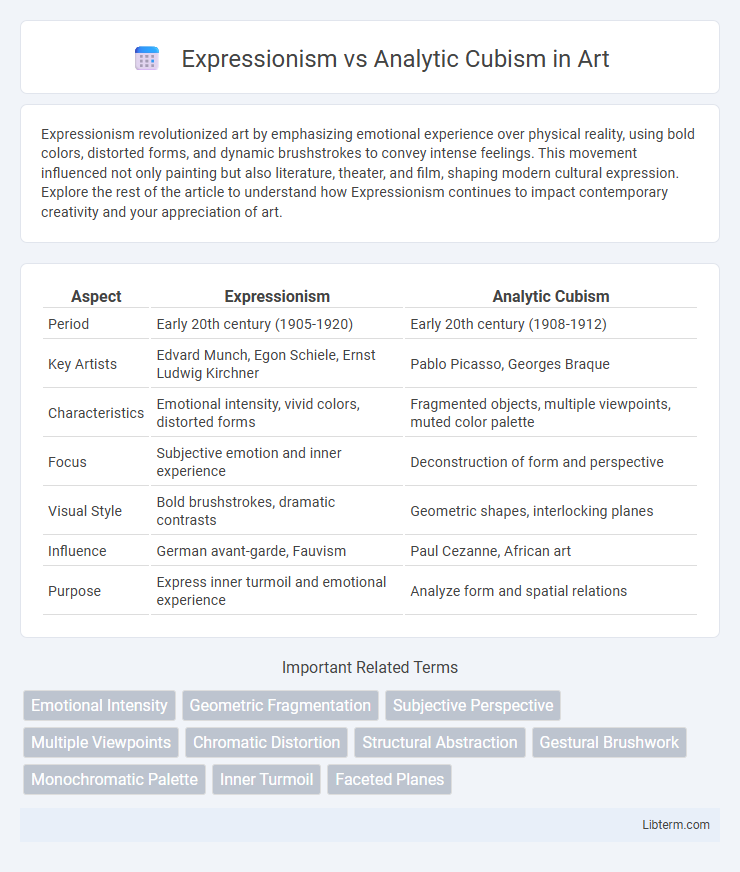Expressionism revolutionized art by emphasizing emotional experience over physical reality, using bold colors, distorted forms, and dynamic brushstrokes to convey intense feelings. This movement influenced not only painting but also literature, theater, and film, shaping modern cultural expression. Explore the rest of the article to understand how Expressionism continues to impact contemporary creativity and your appreciation of art.
Table of Comparison
| Aspect | Expressionism | Analytic Cubism |
|---|---|---|
| Period | Early 20th century (1905-1920) | Early 20th century (1908-1912) |
| Key Artists | Edvard Munch, Egon Schiele, Ernst Ludwig Kirchner | Pablo Picasso, Georges Braque |
| Characteristics | Emotional intensity, vivid colors, distorted forms | Fragmented objects, multiple viewpoints, muted color palette |
| Focus | Subjective emotion and inner experience | Deconstruction of form and perspective |
| Visual Style | Bold brushstrokes, dramatic contrasts | Geometric shapes, interlocking planes |
| Influence | German avant-garde, Fauvism | Paul Cezanne, African art |
| Purpose | Express inner turmoil and emotional experience | Analyze form and spatial relations |
Introduction to Expressionism and Analytic Cubism
Expressionism emerged in the early 20th century as an art movement emphasizing emotional experience over physical reality, characterized by distorted forms and vivid colors to evoke subjective feelings. Analytic Cubism, pioneered by Pablo Picasso and Georges Braque, deconstructs objects into fragmented geometric shapes and depicts multiple viewpoints simultaneously to analyze form from various perspectives. Both movements challenged traditional representation, with Expressionism focusing on emotional intensity and Cubism on structural analysis.
Historical Context and Origins
Expressionism emerged in early 20th-century Germany as a reaction to industrialization and social upheaval, emphasizing emotional experience over physical reality through distorted forms and vivid colors. Analytic Cubism originated in Paris between 1908 and 1912, pioneered by Pablo Picasso and Georges Braque, breaking down objects into geometric shapes to depict multiple perspectives simultaneously. Both movements challenged traditional artistic conventions, but Expressionism focused on subjective emotion while Analytic Cubism explored fragmented perception and abstraction.
Key Artists and Influential Works
Expressionism, epitomized by artists like Edvard Munch and Egon Schiele, emphasizes emotional experience through bold colors and distorted forms, with key works such as Munch's "The Scream" and Schiele's self-portraits showcasing intense psychological depth. Analytic Cubism, pioneered by Pablo Picasso and Georges Braque, deconstructs objects into geometric shapes and multiple perspectives, exemplified in Picasso's "Les Demoiselles d'Avignon" and Braque's "Violin and Palette," which analyze form and space. Both movements revolutionized early 20th-century art by challenging traditional representation but diverged in focus: Expressionism centers on subjective emotion, while Analytic Cubism explores abstracted structure.
Defining Characteristics of Expressionism
Expressionism emphasizes intense emotional experience through distorted forms, vivid colors, and dynamic brushwork to evoke subjective feelings rather than realistic representation. It often portrays inner turmoil and psychological states, using exaggerated and non-naturalistic elements to communicate mood and meaning. Key figures include Edvard Munch and Egon Schiele, whose works exemplify this raw, emotive style contrasting with the fragmented, geometric abstraction of Analytic Cubism.
Defining Traits of Analytic Cubism
Analytic Cubism, pioneered by Pablo Picasso and Georges Braque between 1908 and 1912, deconstructs objects into fragmented, geometric shapes analyzed from multiple viewpoints to depict a complex, abstract reality. It features a monochromatic color palette, emphasizing form and structure over color to explore the essence of subjects through overlapping planes and interlocking facets. This style contrasts with Expressionism, which prioritizes emotional intensity and vibrant colors to convey subjective experiences rather than the objective dissection of forms characteristic of Analytic Cubism.
Techniques and Materials Used
Expressionism emphasizes bold brushstrokes, vivid colors, and distorted forms to convey emotional intensity, often utilizing oil paints on canvas and incorporating mixed media for texture. Analytic Cubism deconstructs objects into geometric shapes and multiple perspectives, employing muted color palettes with oil and paper collage fragments to create layered, abstract compositions. Techniques in Expressionism highlight spontaneity and emotional depth, while Analytic Cubism focuses on systematic fragmentation and intellectual analysis through precise brushwork and collage integration.
Approach to Form and Perspective
Expressionism emphasizes distorted forms and exaggerated perspectives to convey emotional intensity and subjective experience, often using bold colors and dynamic brushstrokes to enhance emotional impact. Analytic Cubism breaks down objects into geometric shapes and multiple viewpoints, fragmenting and reassembling forms to depict different perspectives simultaneously on a flat canvas. This analytical approach to form rejects traditional single-point perspective, focusing instead on deconstructing and reinterpreting reality through intersecting planes.
Emotional vs. Analytical Approaches
Expressionism emphasizes intense emotional experience through distorted forms and bold colors, aiming to evoke subjective feelings and psychological states. Analytic Cubism prioritizes a methodical analysis of objects by breaking them into geometric shapes and multiple perspectives, focusing on intellectual interpretation rather than emotional impact. These contrasting approaches highlight the divergence between art driven by raw emotional expression and art constructed through intellectual deconstruction and spatial examination.
Influence on Modern Art Movements
Expressionism's emphasis on emotional intensity and subjective perspective significantly influenced Abstract Expressionism and Neo-Expressionism by promoting bold color use and distorted forms to convey inner experiences. Analytic Cubism's methodical fragmentation of objects into geometric shapes laid the groundwork for movements like Futurism and Constructivism, inspiring artists to explore multiple viewpoints and spatial abstraction. Both movements redefined artistic representation, shaping the development of 20th-century modern art through their innovative approaches to form and emotional expression.
Legacy and Lasting Impact
Expressionism's legacy lies in its profound influence on modern art by emphasizing emotional experience and subjective interpretation, inspiring movements such as Abstract Expressionism and impacting visual arts, literature, and theater. Analytic Cubism revolutionized artistic representation through its deconstruction of objects into geometric forms and multiple perspectives, laying the groundwork for later developments in modernism, including Synthetic Cubism and Futurism. Both movements permanently altered the trajectory of visual art by challenging traditional techniques and introducing new ways to perceive reality and form.
Expressionism Infographic

 libterm.com
libterm.com